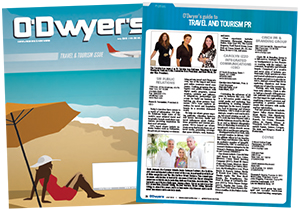 Jennifer Hawkins Jennifer Hawkins |
|
|
This ability to spot change and be flexible adapters is an asset we use as we create our clever campaigns. Keeping up with the modes of communication alone when reaching out to journalists requires a full-court team (Snail mail! Faxes! Phone calls! Emails! Tweets!), and with the emergence of Instagramers and bloggers as “media targets,” publicists must constantly be one step ahead of the changing media landscape in order to do our jobs well. But savvy PR pros know that change and evolution can also be our best ally. Change is the driving force behind trends and they can be the secret weapon for keeping our clients in the news — not to mention ahead of the curve in their industries — and for enticing media to look to us as expert resources for insight on what’s hot and what’s next.
Trends have been “getting ink” and dominating headlines since pamphlets were first passed on horseback during the American Revolution. In 1774, the Virginia Gazette was one of the first newspapers to record fashion trends regarding Colonial dress codes, documenting everything from powdered hair pieces to hoop skirts and knee breeches, to how slaves mended, patched and embellished their clothing to create an individual style. Despite hundreds of years — not to mention the hundreds of media outlets that have come and gone since —trends have prevailed as one of the most frequently covered topics by media. Take for example The Wall Street Journal, where recent headlines include everything from “A Furniture Trend that Will Rope You In” to “Broccoli Rabe is Trying to be the Next Kale” and “Are High-Tech Hotels Alluring — or Alienating?” So while virtually everything has changed since the Virginia Gazette’s debut, it’s safe to say that the concept of reporting on fashions and societal inclinations has remained relevant content.
Trends by their very nature are driven by the human need for “new” —the variations in human interest, in conversation, communication, and in global news. Consider the current trend of luxury experiential travel — where affluent travelers are shifting away from simple leisure and seeking more authentic, hands-on memory-driven adventures. Our fabulously creative Napa Valley client knows travelers don’t just want to order an expensive bottle of wine to accompany their gourmet meal, they want to visit the vineyard, pick the grapes, cultivate wine and bottle it themselves. Nothing tastes sweeter than sipping the fruits of your labor. This trend may seem fleeting, but it was inspired by a variety of complex cultural and socio-political issues as consumers are aspiring to connect to a local destination and understand where their food and beverages come from, wanting to become familiar with indigenous customs, and ultimately demanding that their vacations provide genuine, authentic experiences.
Understanding and recognizing where society’s interests are piquing, it’s clear that any publicist worth their salary, is a voracious media follower. Devouring news from every source — pop culture publications and hard news channels, influencer posts and sponsored content from big brands. The simple notion of reading anything and all, yet editing and curating what we digest is one of the gifts a great PR pro possesses. It is the 360-degree perspective — news, pop culture, politics, economics — that collides to create an overlap in interest and ultimately groundswell trend. Being a skilled trend-spotter also lends itself to cleverly packaging them and turning them into press for clients. That way they don’t have to be the news, they just have to be in the news.
In being global experts, we can make educated recommendations on what will hook a potential new guest or story-searching journalist. For example, informed of the rise of beer tourism in Vermont, and at a time when craft beer was still just an under-the-radar niche beloved by a tight-knit group of “beer geeks,” our team identified an opportunity for our new boutique hotel client in Burlington, VT. After being introduced to one of the front desk agents, we quickly learned about his personal passion for this rising trend, and recommended leveraging him to create Vermont’s first and only “Beer Concierge.” What initially started as an informal guest resource for local brewery recommendations evolved into an entire campaign and identity for the property as it created a dedicated hotel package and local tour around the concept. The Beer Concierge program has resulted in more than 170 million print and digital media impressions ranging from The New York Times, Food & Wine, Condé Nast Traveler, Travel + Leisure and Forbes.com. The property also generated over $25,000 in revenue throughout the campaign. This was a true testament to the fact that trends drive media awareness and income.
While the evolution of some trends is organic, there is an overarching strategy behind trend-spotting. In addition to daily client counsel, our dedicated team also has a streamlined plan to help our clients prepare for trends throughout the year. We brainstorm and outline relevant trend-driven content containing specific client examples and how to pitch media accordingly. This allows us to not only share forthcoming trends with our clients, but ensure that they’re included and therefore part of the trend stories that will permeate the media — from interactive Olympic programming that helps guests celebrate the summer games to highlighting Presidential stays at historic properties ensuring inclusion in Presidential election coverage.
Considering trend-spotting as part of our scope-of-work with every single client is extremely important. It benefits our clients because it results in quality media coverage that positions them as trendsetters, ultimately driving awareness and in many cases business. At the same time, it helps us publicists because we’re able to package our variety of travel clients’ news as ready-made trend stories to media and serve as an invaluable and trusted resource to journalists.
* * *
Jennifer Hawkins is founder and president of Hawkins International Public Relations.



 Weber Shandwick is providing PR and marketing communications services to the Moroccan National Tourist Office in New York.
Weber Shandwick is providing PR and marketing communications services to the Moroccan National Tourist Office in New York. Finn Partners has filed its six-month contract with the Bahamas Ministry of Tourism, Investments & Aviation, which is worth $240K.
Finn Partners has filed its six-month contract with the Bahamas Ministry of Tourism, Investments & Aviation, which is worth $240K. Weber Shandwick wrapped up its work for the Ministry of Bahamas at the end of 2023.
Weber Shandwick wrapped up its work for the Ministry of Bahamas at the end of 2023. The Aruba Tourism Authority is boosting its budget 29.4 percent to $2.2M at Zeno Group, according to its 2024 contract, effective Jan. 1.
The Aruba Tourism Authority is boosting its budget 29.4 percent to $2.2M at Zeno Group, according to its 2024 contract, effective Jan. 1. As inflation continues to impact spending, consumers are revisiting their list of what they’re willing to spend more of their money on. Luckily for those in the travel industry, experiences seem to be trending up on the “splurge” list.
As inflation continues to impact spending, consumers are revisiting their list of what they’re willing to spend more of their money on. Luckily for those in the travel industry, experiences seem to be trending up on the “splurge” list. 


 Have a comment? Send it to
Have a comment? Send it to 
No comments have been submitted for this story yet.